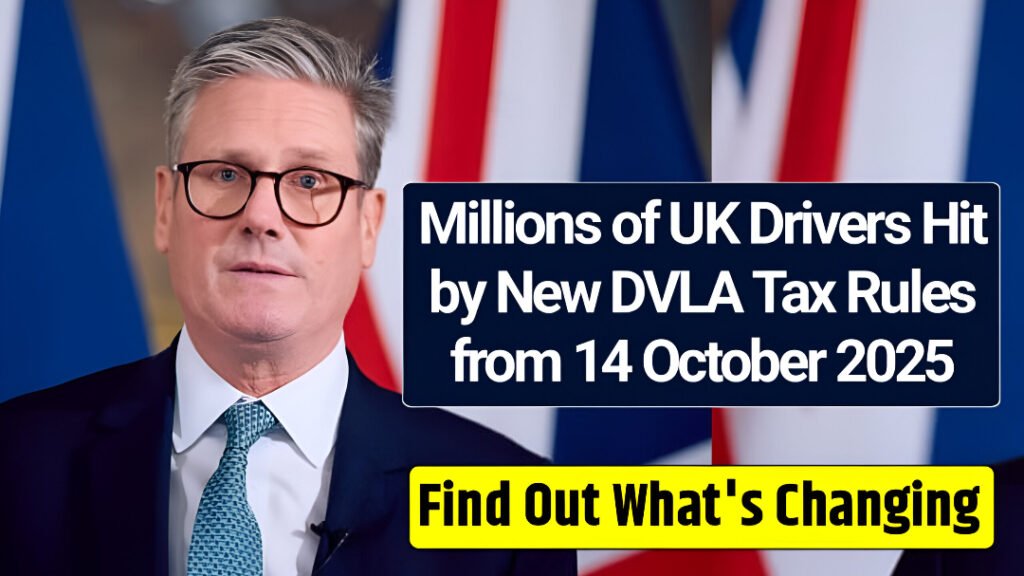Hello Everyone, The UK government has announced significant changes to vehicle tax regulations that will come into effect from 14 October 2025. Millions of drivers across the country are expected to be affected, as these changes aim to modernise the system and ensure fair taxation. The update has sparked concerns among motorists, particularly those with older vehicles or multiple cars registered under their name.
The new DVLA rules are part of a broader government initiative to streamline tax collection, reduce fraud, and encourage environmentally friendly driving. With this update, drivers must stay informed to avoid fines, penalties, or unexpected charges.
Who is Affected
The new rules will impact all registered vehicle owners in the UK. While some changes apply universally, others target specific groups such as:
-
Owners of older vehicles.
-
Individuals with multiple vehicles.
-
Drivers who previously relied on exemptions or discounts.
It is crucial for affected drivers to check their current tax status and understand how the new regulations apply to them. Ignorance could result in unexpected penalties.
Key Changes Explained
The DVLA has highlighted several important modifications to vehicle tax regulations, including:
-
New Emission-Based Taxation: Vehicle tax will now be more closely linked to CO2 emissions. Higher-emission cars will face increased rates.
-
Automatic Renewal Updates: The system will automatically calculate and renew tax based on updated vehicle information.
-
Digital Notification System: Drivers will receive reminders and updates via email or SMS, reducing the chance of missing deadlines.
These changes are intended to promote greener driving habits and make tax compliance easier for everyone.
How to Check Your Vehicle Tax
Before the rules take effect, drivers should verify their current tax status. The DVLA website provides a simple tool to check the details of any vehicle registered in the UK. Steps to check your vehicle tax:
-
Visit the official DVLA website.
-
Enter your vehicle registration number.
-
Review your tax status, expiry date, and any outstanding charges.
-
Update details if necessary to avoid penalties.
Ensuring your information is accurate will save time and prevent unnecessary fines under the new system.
Financial Impact on Drivers
The new rules could have a significant financial impact, especially for drivers with older or high-emission vehicles. Experts predict:
-
An increase in tax for vehicles that emit more CO2.
-
Higher costs for individuals with multiple vehicles.
-
Savings for low-emission vehicle owners due to reduced tax rates.
The government hopes that linking tax rates to emissions will encourage environmentally friendly choices while generating necessary revenue for public services.
Government Perspective
Officials emphasise that the changes are part of a long-term strategy to modernise vehicle taxation and support environmental policies. A government spokesperson stated:
The new DVLA tax rules are designed to make the system fairer, simpler, and more transparent. Linking vehicle tax to emissions encourages greener driving and ensures everyone pays their fair share.
The government also insists that safeguards will be in place to assist older drivers and those unfamiliar with digital platforms.
Public Reaction
The announcement has sparked mixed reactions. While environmental groups welcome the move, many drivers express concerns about potential costs.
-
Low-emission vehicle owners generally support the changes.
-
Owners of older or classic cars are worried about higher tax rates.
-
Motorists with multiple vehicles are seeking clarity on combined taxation rules.
Social media and local news outlets are abuzz with discussions, reflecting the national interest and impact of these new regulations.
Comparison with Previous Rules
Previously, vehicle tax rates were less directly linked to emissions, and renewal processes required more manual intervention. Some key differences include:
-
Emission-based taxation replaces the older blanket system.
-
Automatic renewals reduce the risk of missed deadlines.
-
Digital notifications improve awareness and compliance.
These changes mark a shift towards a more streamlined, environmentally conscious system that is easier to manage for both drivers and the DVLA.
How This Supports the UK
The new rules are designed to support multiple government objectives:
-
Reducing carbon emissions from vehicles.
-
Encouraging drivers to upgrade to greener cars.
-
Ensuring efficient tax collection for infrastructure and public services.
By linking taxation to emissions and simplifying the process, the government hopes to promote sustainable transport and reduce bureaucratic hurdles for motorists.
Tips for Drivers
Drivers can take proactive steps to minimise the impact of these changes:
-
Review your current vehicle’s tax category and CO2 emissions.
-
Consider upgrading to a low-emission or electric vehicle.
-
Keep personal and vehicle information up-to-date with the DVLA.
-
Use the digital reminder system to ensure timely renewals.
These measures will help drivers avoid penalties and benefit from potential savings under the new rules.
Expert Opinions
Policy analysts and automotive experts have provided insights into the expected effects:
-
Financially, high-emission vehicle owners may see an increase in annual costs.
-
Environmentally, the new system incentivises greener driving.
-
Technologically, digital notifications reduce missed deadlines and errors.
Experts agree that while some drivers may face higher costs, the system promotes fair taxation and sustainability.
Potential Challenges
Some challenges may arise during the transition:
-
Drivers unfamiliar with online systems may struggle with digital notifications.
-
Vehicle owners with older cars may face unexpected tax increases.
-
Ensuring nationwide awareness and compliance may require extensive communication efforts.
The government plans to provide support through phone, email, and local offices to minimise these challenges.
Conclusion
The new DVLA tax rules coming into effect from 14 October 2025 represent a major shift for UK drivers. By linking vehicle tax to emissions and streamlining renewal processes, the government aims to encourage environmentally friendly driving, simplify compliance, and ensure fair taxation.
While some drivers may face increased costs, particularly those with older or high-emission vehicles, the overall goal is to create a more sustainable and efficient system. Staying informed and updating vehicle details ahead of the deadline is crucial to avoid penalties and make the most of this new regulatory framework.
